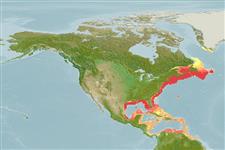Classification / Names
Common names from other countries
Main reference
Size / Weight / Age
Max length : 152 cm TL male/unsexed; (Ref. 26938); 122.0 cm TL (female); common length : 50.0 cm TL male/unsexed; (Ref. 3242); max. published weight: 7.3 kg (Ref. 4699); max. reported age: 43 years (Ref. 40922)
Length at first maturity
Lm ?, range 37 - 100 cm
Environment
Marine; freshwater; brackish; demersal; catadromous (Ref. 26938); depth range 0 - 464 m
Climate / Range
Subtropical; 4°C - 25°C (Ref. 12468), preferred 7°C (Ref. 107945); 66°N - 7°N, 98°W - 21°W
Distribution
Short description
Dorsal
spines
(total): 0;
Anal
spines: 0. Head rather long; eyes small and placed well forward on head. Lips thick. Caudal vertebrae without transverse processes. Premaxillae not developed as distinct elements in adults. Frontal bones paired, not grown together. Pectoral girdle with 7 to 9 (up to 11 in the young) radial elements. Adults usually white or light-colored below and brownish to blue-black above, but coloration is variable; young with some yellow on the edges of the dorsal and anal fins (Ref. 30499). Caudal fin rounded, joined to dorsal and anal fins. Gill opening on side in front of lower half of well-developed pectoral fin; lower jaw longer than upper; 103-111 vertebrae (Ref. 26938).
IUCN Red List Status (Ref. 115185)
Threat to humans
Harmless
Human uses
Fisheries: commercial; aquaculture: commercial; gamefish: yes; aquarium: public aquariums
Tools
Special reports
Download XML
Internet sources
Estimates of some properties based on models
Phylogenetic diversity index
PD50 = 0.5000 many relatives (e.g. carps) 0.5 - 2.0 few relatives (e.g. lungfishes)
Trophic Level
3.8 ±0.2 se; Based on diet studies.
Resilience
Medium, minimum population doubling time 1.4 - 4.4 years (tm=3-6; Fec=5,000,000)
Vulnerability
Very high vulnerability (83 of 100)
Price category
